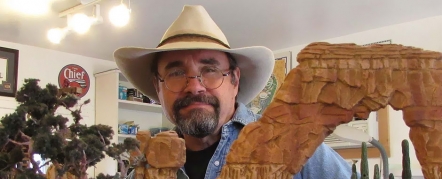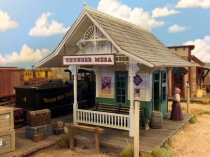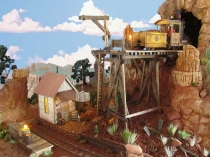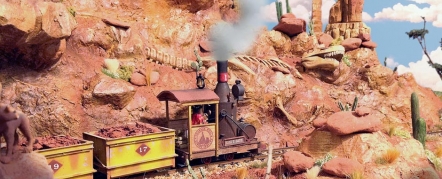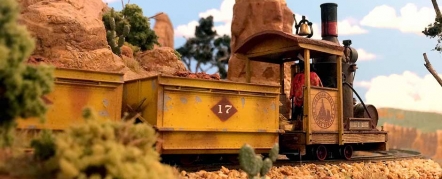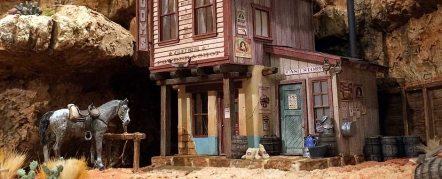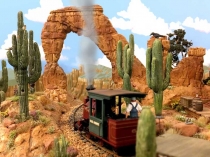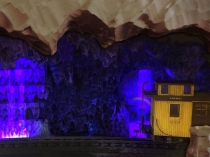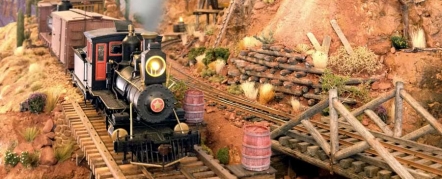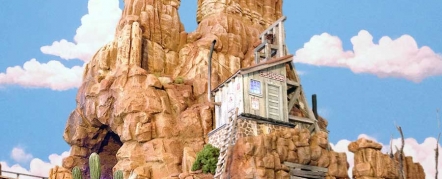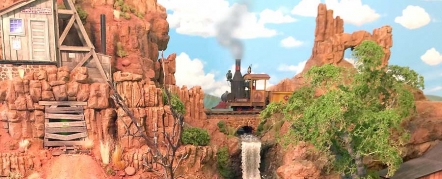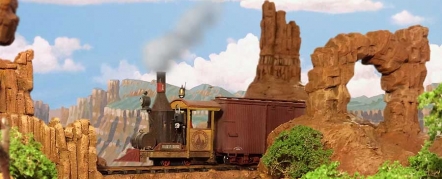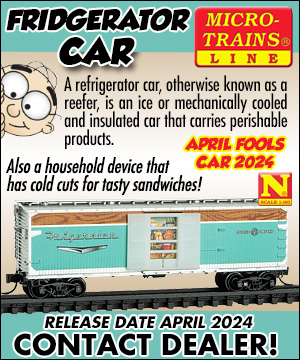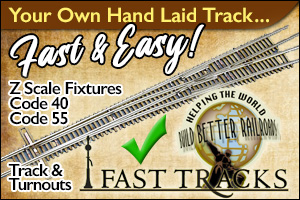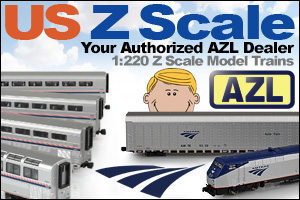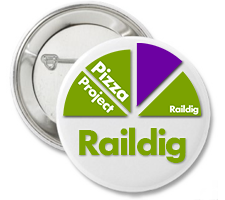Dave Meek | On30 Thunder Mesa Mining Co.
During a recent YouTube poking around session, I came across a model railroad video that just made me smile. Not that I wasn’t impressed with the On30 scenery (I was), and not that I didn’t appreciate the quality of the video production (I did), but the video just made me happy enough to watch it several times over.
I found the creator of this layout, the Thunder Mesa Mining Co., Dave Meek, and dropped him an email and, well… here we are. I really like Dave’s approach to modeling and I think you will too. Enjoy!
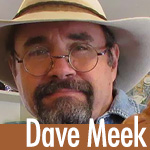 Your Thunder Mesa Mining Co. layout is On30-based, what is it about On30 that appeals to you?
Your Thunder Mesa Mining Co. layout is On30-based, what is it about On30 that appeals to you?
I find On30 to be the perfect scale/gauge combination for what I’m trying to do in the space that I have to do it in. 1:48 scale gives you models with some heft where you can really go crazy with the details if you want to and I love to scratchbuild structures. The 30” gauge means I can get away with stuffing a lot of railroad into a relatively small area. Thunder Mesa only covers about 128 square feet. Plus there’s the added bonus of being able to tinker with HO scale mechanisms and things for engines and rolling stock. Also I’ve found that the scale looks good in photographs and that’s become a big part of the hobby for me. It’s just big enough to create the believable scenes I’m after, but not so big that I have to build it outside.
Have you always modeled in On30 and, how long have you been involved in model railroading?
No. I started in N scale when I was a kid back in the ‘70s – so, almost 40 years in the hobby now. I’ve always had some sort of layout going, mostly on the small and portable side. I’ve also dabbled in HO, HOn3, Nn3 and even a little G scale here and there. Just about every layout I’ve ever attempted has had a western, mountain flavor to it and Thunder Mesa actually started out in HO scale in its first incarnation as the Big Thunder & Western. That didn’t last long though and I decided to trade all of my HO stuff for On30 when I began the layout again in 2012.
Being a New Yorker who has a connection with Florida, Disney World is etched in my memories. I see a strong familiarity with your Thunder Mesa Mining Co. and the overall Disney-feel, how did this develop for you?
I grew up in Orange County, California, about a half hour away from Disneyland and I spent a lot of time there as a kid in the ‘60s and ‘70s. That had a big influence. I could draw, and my first goal was to be a Disney animator when I grew up. Later, I learned I had more aptitude for illustration, character and concept design and began a career as a freelancer. Through my design career I’ve developed a great admiration for just how well Disney does things and made it sort of a hobby to learn as much as I could about their processes. Thunder Mesa has really become an outgrowth of that. I think what I’d like people to understand most about the project is that it is not meant to be a model of any specific Disney scene or attraction. Rather, it is a project that follows Disney’s design philosophy to create something entertaining in the same way that they do it.
I’m often asked if I work at Walt Disney Imagineering and this is very flattering (usually followed by, “can you get me a job there?” Sorry, no. I can’t even get me a job there). I don’t work for WDI, but I have worked freelance with Disney artists and am fortunate enough to know some people there. They’ve been amazingly supportive of what I’m doing with the layout.
Without a doubt, the biggest takeaway I get from your work is an unabashed sense of fun. It almost seems silly to ask, given that we’re all involved with model trains, but how important is this sense of fun to you and the Thunder Mesa Mining Co.?
Well, that’s the whole point isn’t it? I can’t speak for others in the hobby, but my motivation comes from recreating that child-like sense of wonder we all experienced the first time we ever saw a model train. Why should Christmas only come once a year? People need places to play. Even grown-ups. Heck, especially groan-ups. The goal of Thunder Mesa is to create an immersive, entertaining, believable world to play in. Model railroading can be so much more than just a dry exercise in miniature engineering; it can take us away to another time and place. Using artistry, illusion, and stagecraft it becomes a place for stories to happen. It’s okay to have fun and I take that fun very seriously.
In On30, Bachmann is a (the) primary manufacturer of locomotives and probably rolling stock as well. Have you found this to be a problem, having one manufacturer producing the bulk of your trains?
Thank goodness for Bachmann! I might still be in On30 without them but it would be much, much more difficult. The ready availability of their On30 Porter and other equipment is really what convinced me to switch from HO to On30 in the first place. They definitely created the market and continue to be way out in front of what anyone else is offering. Are there things I would do differently if I were them? Sure. But if there’s something I want that they don’t make, I usually know how to find it or can build it myself. If Bachmann suddenly went away tomorrow, the TMMC would carry on. On30 would take a hit but someone else would probably jump into the market in their absence.
Can you give us some details of the Thunder Mesa Mining Co. in terms of brands of track, DCC equipment, etc.
I use Peco On30 track and turnouts on the entire layout. It’s a design choice I made early on. When well laid and maintained, the Peco track operates flawlessly, and those chunky looking ties really make it look like a caricature of narrow gauge track. It works perfectly for the Disney design aesthetic. To run the layout I use an NCE powercab, though that’s due to be upgraded soon with a booster and an additional handset. Most of the locomotives have Tsunami sound decoders. The ruling grade on Thunder Mesa is 3%, with one 6% stretch on the branchline up to Big Thunder Camp. The tightest curve has a radius of 15” so the largest locomotive I can run is the Bachmann 4-4-0.
Your display a wide variety of skills on the Thunder Mesa Mining Co. layout and website: design, construction, color, photography, lighting and overall presentation. How did you get this good in these areas?
Well, thank you. I guess as a freelance artist living in a rural area I’ve had to develop many skills since I’m something of a one-man-shop. I’ve taught myself photography but still have much to learn. The color and design stuff I learned in school and on the job. All of the hobby related skills like benchwork, trackwork, wiring, and scenery have come from building several layouts over the years and a few commercial displays. Scenes and transitions, lighting and presentation, working from story, I learned from Disney. There’s a master-course in design there if you take time to study how and why the original Imagineers did things.
I see you also have some On18 and N scale work on your website. What sort of challenges do you find in working between On30 and with these very different scales?
So far the biggest challenge to working on the N scale and On18 projects has been finding the time! The N scale Pagosa & Southern shelf layout is almost permanently on the backburner these days as I have been much more interested in working on the big railroad. The On18 Calico layout will be getting some more attention In the near future since it ties in with the TMMC and will contribute to its operations. On18 is, of course, a challenge since nearly everything needs to be scratchbuilt or bashed from N scale or HOn30 stuff. That’s the fun part! It’s fun to look at things in other scales and wonder, “Now, how can I use this?”
I worked in N scale for a long, long time so I do have some nostalgia for that stuff. Still, just about everything I ever tried to do in N actually works better in the larger scales. That is not a dig against N scale. The truth is, I have always kind of done it wrong, trying to represent funky shortline operations in N, when what the scale really excels at is depicting Class 1 trains of realistic lengths in wide open settings. Each scale has its strengths and weaknesses.
From the builder’s point of view, what are some of the things you’d like people to know, or learn about, when putting together a layout like the Thunder Mesa Mining Co.?
Have fun with it! That’s my one rule. If you’re not having fun, you’re doing it wrong. Model railroading is a hobby, not a job; it is a form of entertainment and creative relaxation. Remember that there is no governing authority and there’s nobody in charge. No matter what you choose to do, there are plenty of self-appointed experts who will tell you that you’re doing it wrong. Do it anyway. They are not your audience. A person who can no longer see the train for the rivets has lost track of that childlike sense of wonder that made him or her love models in the first place.
Let’s face it, the Thunder Mesa Mining Co. is an improbable railroad built along a right-of-way filled with an unlikely number of amazing scenes. C’mon, nobody would build a railroad under a natural arch, or over a geyser-field, or through those glittering caverns. The costs would be astronomical and it would never happen! Besides, there’s no gold in sandstone anyway so you don’t even find mines in places like that. Indeed, the canyons are too deep, the bridges are too rickety, and the mines are too small to support such a lavish operation. It’s just not realistic.
No, it’s not realistic. Fortunately, realism is not what I’m going for. The layout is a themed environment, a storytelling space, not a treatise on 19th Century railroad and mining practices. The goal of the layout is entertainment through world building and for that it need only be true to its own story. Like a good popcorn-munching summer blockbuster, it needs only believability, not realism. Thunder Mesa is a tall tale. I live in Arizona and the cowboys around here have a saying: Never let the truth get in the way of a good story.
I would tell any would-be layout builder that model railroading is a storyteller’s medium. The main thing to decide is what kind of story you want to tell. It can be fact or fiction, historical or fantastical, the point is to use that as a starting point for the type of modeling you’d like to do. Everything else is just tools and raw materials.
Article Links
Thunder Mesa Mining Co. Website
http://thundermesaminingco.blogspot.com/Thunder Mesa Mining Co. On Facebook
Thunder Mesa Mining Co. FacebookThunder Mesa Mining Co. On YouTube
https://www.youtube.com/channel/UC2JtlZ2I6X4o1eFKSdJaMswBachmann Trains On30
Link to Bachmann’s On30 Online Store
Category: Raildig Guest




